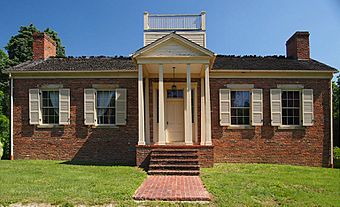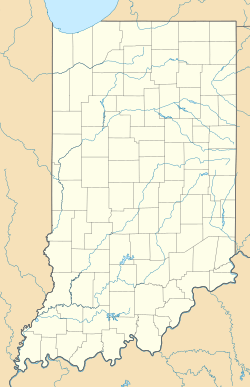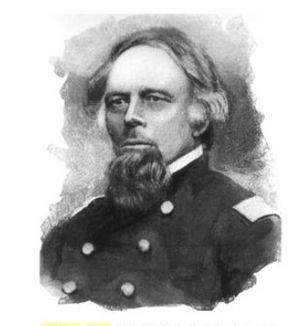Colonel William Jones House facts for kids
Quick facts for kids |
|
|
Col. William Jones House
|
|

South facade
|
|
| Location | Boone Street, Gentryville, Indiana |
|---|---|
| Area | 5 acres (2.0 ha) |
| Built | 1834 |
| Architectural style | Federal |
| NRHP reference No. | 75000050 |
| Added to NRHP | May 12, 1975 |
The Colonel William Jones House, also known as the William Jones State Historic Site, is an old house in Gentryville, Indiana. It's also part of the Lincoln State Park in Spencer County, Indiana. This house is important because it was added to the National Register of Historic Places on May 12, 1975.
William Jones (1803–1864) was a busy man. He was a farmer, a merchant (someone who sells things), a soldier, and even a politician. He lived, farmed, and ran a store in the Little Pigeon Creek Community, which is now part of Gentryville. A very famous person, Abraham Lincoln, who lived nearby, even worked in Jones's store! During the American Civil War, William Jones was a soldier. He became a lieutenant colonel and sadly died during the Battle of Atlanta on July 22, 1864. He was made a colonel on that same day.
Contents
Who Was William Jones?
William Jones was born on January 5, 1803, in Vincennes, Indiana. He grew up around important people and events, and he received a good education. When he was older, he trained to work for a large company that sold dry goods (like fabrics and clothing) in Louisville, Kentucky.
William married Fanny Payne, but sadly, their two young children passed away when they were little. He then moved from Kentucky and opened a successful store in Jonesboro, Indiana, in 1827. He lived in a log cabin nearby. In 1830, he married Rachel Oskins, and they had five sons.
Jones's Business and Lincoln's Connection
Jones's store was very active. He sold and traded many items. He also helped farmers by shipping their crops, tobacco, animal hides, pork, venison, and beef to New Orleans using flatboats. He even became the local postmaster, which meant he was in charge of the mail.
In 1829, Jones hired Abraham Lincoln, who lived just a few miles away. Lincoln helped butcher meat, process it, and unpack boxes in the store. Lincoln loved to read, and he read all of Jones's books. Jones once said that "Lincoln would make a great man one of these days."
Jones's Role in Politics and the Civil War
William Jones was elected to the Indiana General Assembly in 1838. This is like being a state lawmaker. He worked to improve roads and help the economy grow. He served in this role until 1841.
Jones was a strong supporter of Henry Clay and the Whig Party. He was very upset when Clay lost the presidential election. Abraham Lincoln, who was then a Whig politician in Illinois, had heard Jones's political ideas. Lincoln even stayed at the Jones House in 1844 when he was campaigning for Clay. Later, both Jones and Lincoln became members of the Republican Party after the Whig Party ended.
In the 1850s, Jones moved to Gentryville, Indiana and opened another store there. When the American Civil War began, Jones joined the Union army. He became a lieutenant colonel and later a colonel in the 53rd Regiment of Indiana Volunteers. He fought in important battles like the Meridian Expedition, the Siege of Corinth, and the Battle of Atlanta. Sadly, he died in the Battle of Atlanta on July 22, 1864, after being wounded. He was buried at the Marietta National Cemetery in Georgia.
The William Jones House
William Jones built his house around 1834, right across the street from his log cabin. He built it when his businesses made him successful. This house is a one-story brick building with five rooms. It's built in the Federal style, which was popular at the time. Around 1887, a Greek-style front porch with columns was added, giving it a Classical Revival look. The house also has a small loft and a "captain's walk" on the roof.
It's believed that Lincoln's father, Thomas Lincoln, built the corner cupboard in the kitchen. The house is located on one of the highest points in the area. The Jones Home shows how people became wealthier and how the economy changed during that time. It represents successful business owners who chose to stay in Southern Indiana instead of moving further west.
House Ownership and Preservation
In the early 1850s, Jones moved to Gentryville, and his house was sold to different owners over the years. In 1887, George and Arietta Bullock bought the house, and it stayed in their family until 1976. Then, Gayle and Bill Cook bought it and worked to restore it to its original condition.
The house was officially added to the National Register of Historic Places in 1975. In 1990, the house and 100 acres of land were given to the Indiana Department of Natural Resources (IDNR) to help preserve this important piece of history.
The Town of Jonesboro
Around William Jones's house and store, about a dozen cabins were built. By 1831, this small settlement became known as Jonesboro. It's important not to confuse this old Jonesboro with the current Jonesboro in Grant County, Indiana.
Besides Jones's house and store, the settlement of Jonesboro also had a school, a doctor's office, and a blacksmith. However, after William Jones moved his store and post office to Gentryville, the original Jonesboro was "forgotten" and faded away.




